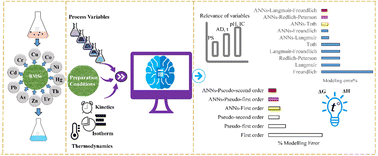Application of neural network in metal adsorption using biomaterials (BMs): a review†
Abstract
With growing environmental consciousness, biomaterials (BMs) have garnered attention as sustainable materials for the adsorption of hazardous water contaminants. These BMs are engineered using surface treatments or physical alterations to enhance their adsorptive properties. The lab-scale methods generally employ a One Variable at a Time (OVAT) approach to analyze the impact of biomaterial modifications, their characteristics and other process variables such as pH, temperature, dosage, etc., on the removal of metals via adsorption. Although implementing the adsorption procedure using BMs seems simple, the conjugate effects of adsorbent properties and process attributes implicate complex nonlinear interactions. As a result, artificial neural networks (ANN) have gained traction in the quest to understand the complex metal adsorption processes on biomaterials, with applications in environmental remediation and water reuse. This review discusses recent progress using ANN frameworks for metal adsorption using modified biomaterials. Subsequently, the paper comprehensively evaluates the development of a hybrid-ANN system to estimate isothermal, kinetic and thermodynamic parameters in multicomponent adsorption systems.

- This article is part of the themed collections: Environmental Science Advances Recent Review Articles, Artificial Intelligence and Machine Learning in Environmental Science and Topic Collection: Wastewater Treatment


 Please wait while we load your content...
Please wait while we load your content...